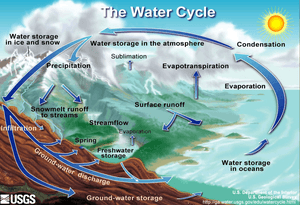Water cycle facts for kids
The water cycle is how water moves all around Earth. It's super important for all life! Water has been on Earth since it first formed.
Even though water moves a lot, the total amount of water on Earth stays pretty much the same. Water can be found in different places, like ice, fresh water, salty ocean water, and even in the air. Where the water is depends on the weather.
Water is always moving from one place to another. For example, it can go from a river to the ocean, or from the ocean into the air. This movement happens through different steps: evaporation, transpiration, condensation, precipitation, sublimation, infiltration, surface runoff, and water flowing underground. As it moves, water can change its form: it can be a liquid, a solid (like ice), or a gas (like water vapor). The ocean is a huge part of the water cycle because most of the water that goes into the air comes from there.
Contents
How Does the Water Cycle Work?
The water cycle is a continuous journey water takes. It has several main steps that keep water moving around our planet.
Evaporation and Transpiration
- First, water on the Earth's surface turns into a gas. This is called evaporation. The sun's heat makes water from oceans, lakes, and rivers rise into the air.
- Plants also release water vapor into the air. This process is called transpiration. It's like plants sweating!
Condensation: Forming Clouds
- Next, the water vapor in the sky gets cold. When it cools down enough, it turns back into tiny liquid water droplets or ice crystals. This process is called condensation.
- These tiny droplets and crystals gather together to form clouds.
Precipitation: Water Falling Back
- Then, the water in the clouds gets too heavy. It falls back to Earth as precipitation. This can be rain, snow, sleet, or hail.
- Precipitation is how water returns to the Earth's surface from the atmosphere.
Collection and Runoff
- Once the water falls, some of it soaks into the ground. This is called infiltration. It can become groundwater stored in aquifers.
- Other water flows over the land, which is called surface runoff. This water collects in lakes, rivers, and eventually flows back into the oceans.
- From these places, the water evaporates again, and the cycle continues!
How Humans Affect the Water Cycle
People do many things that can change the natural water cycle. These activities can impact how much water is available and where it goes.
Farming and Industry
- Agriculture uses a lot of water to grow crops. This water often comes from rivers or underground sources.
- Factories and businesses also use large amounts of water for their processes.
Building Dams
- Building dams creates large lakes called reservoirs. These reservoirs store water for drinking, power, and irrigation.
- However, dams can change the natural flow of rivers and affect ecosystems downstream.
Deforestation and Water Removal
- Deforestation means cutting down many trees. Trees release water vapor through transpiration, so fewer trees can mean less moisture in the air.
- Removing groundwater from wells for homes and farms can lower the water table. This means there's less water underground.
- Taking too much water from rivers, known as water abstraction, can reduce river levels. This impacts plants and animals that live in or near the river.
Images for kids
See also
 In Spanish: Ciclo hidrológico para niños
In Spanish: Ciclo hidrológico para niños





